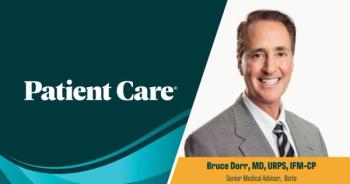
AGS: Geriatricians Go Slow with Newer Chronic Constipation Therapies
SEATTLE -- Few geriatricians appear willing to try newer medications to treat chronic constipation in older adults, an informal survey here showed.
SEATTLE, May 8 -- Few geriatricians appear willing to try newer medications to treat chronic constipation in older adults, an informal survey here showed.
Only about 2% of geriatricians reported having prescribed lubiprostone (Amitiza) and less than 6% said they would suggest over-the-counter PEG 3350 (MiraLax), in an informal survey of audience members at an industry-funded satellite symposium held in conjunction with the American Geriatrics Society meeting.
Their concern may stem in part from recent bad news on the safety of some prescription therapies, which was discussed at the session by Brooks D. Cash, M.D., of the National Naval Medical Center in Bethesda, Md.
The 5-HT4 agonist tegaserod (Zelnorm) was taken off the market on March 30 after 13 patients developed life-threatening cardiovascular events while on the drug.
Another drug that works on the 5-HT receptors, alosetron (Lotronex), was recalled by the FDA in 2000 because of reports of ischemic colitis and severe constipation.
While alosetron was reintroduced with a risk management program in 2002, "the whole concept of playing around with serotonin receptors may have problems," Dr. Cash said.
Also "kind of depressing," Dr. Cash said, is the lack of evidence for commonly used non-prescription strategies.
"There is not a lot of data looking at these therapies in the older population specifically," he said.
Of the bulking agent laxatives, only psyllium has been studied in randomized clinical trials and found beneficial in the general population. None were considered adequate trials in older patients.
"But, I think all of us feel this is reasonable first-line therapy for patients you think can tolerate it," he added.
Stool softeners, such as docusate sodium, have "not been shown to be terribly effective," Dr. Cash said. "I tend to steer away from these."
For probiotics, two studies of the Activa brand of yogurt containing Bifidobacterium animalis showed it significantly reduced intestinal transit time in patients ages 50 to 75.
Stimulant laxatives, such as senna and aloe, have few randomized controlled trials supporting their use. One study suggested that stimulant laxatives were less effective at increasing stool frequency than the osmotic laxative lactulose, although lactulose caused more gas and bloating, Dr. Cash said.
There is good evidence, however, that prescription lactulose and the osmotic laxative PEG 3350, which moved from prescription to over-the-counter status in April, improve stool frequency and consistency as short-term therapy, he said.
In three clinical trials, lactulose showed benefit for the treatment of constipation. PEG 3350 showed benefit over placebo for the treatment of occasional constipation in five randomized controlled trials, which included some older patients.
Two trials showed PEG 3350 to be more effective overall compared with lactulose.
Although there's insufficient data on the osmotic laxative magnesium hydroxide, better known as milk of magnesia, it does appear to help some patients, Dr. Cash said.
Likewise, lubiprostone has been shown to increase stool frequency in older patients with chronic constipation.
In one study, "elderly patients did even a little bit better than nonelderly patients," Dr. Cash noted.
But cost of lubiprostone may be an issue for older patients, Dr. Cash noted. At the recommended twice-daily dose, the cost of a one-month supply of lubiprostone would be , a physician in the audience volunteered.
Dr. Cash suggested starting patients on once-daily dosing since "there is not a huge difference in efficacy."
In clinical practice, lifestyle measures, over-the-counter medications, and laxatives should be the first option explored to treat constipation, he said, provided patients have no alarm symptoms (bleeding, anemia, weight loss, abdominal pain, sudden stool changes).
Lifestyle measures include increasing fluid intake and dietary or supplemental fiber.
Dietary fiber, taken correctly, can decrease colonic transit time and increase stool bulk, noted Karen E. Hall, M.D., Ph.D., of the University of Michigan and VA Healthcare System in Ann Arbor, who chaired the symposium.
However, she said, there is "no evidence that older patients with chronic constipation benefit from high fiber alone."
Low fluid intake also contributes to constipation, but "if they are not already dehydrated it probably won't help" to increase intake, she added.
But, "it's totally reasonable to start lifestyle changes even though there's not great evidence," Dr. Cash said.
The next step would be a trial of lactulose or PEG 3350, followed by a trial of lubiprostone if patients do not respond, he said.
A combination of agents with different mechanisms of action may be helpful as well, said Lin Chang, M.D., of the University of California, Los Angeles.
Consider referring a patient to a gastroenterologist if there is recent-onset constipation associated with alarm symptoms, if chronic constipation necessitates use of high doses of any laxative or is refractory to therapy, or if there is clinical suspicion of pelvic floor dyssynergia, she said.
Newsletter
Enhance your clinical practice with the Patient Care newsletter, offering the latest evidence-based guidelines, diagnostic insights, and treatment strategies for primary care physicians.













































































































































































































































































